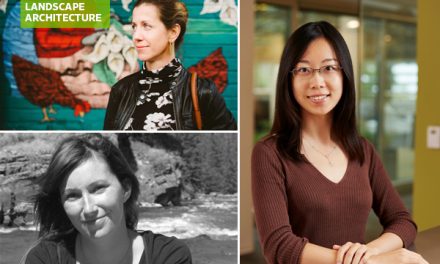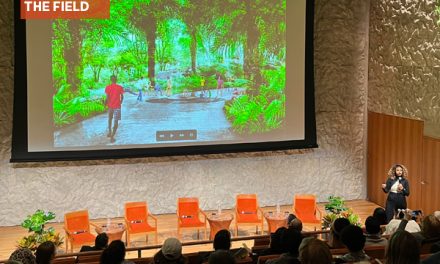ASLA’s Women in Landscape Architecture Professional Practice Network (WILA PPN) is sharing the next set of profiles of women in the profession (see last week’s right here). If you’d like to be featured, the PPN’s call for submissions will remain open, with profiles being shared on an ongoing basis.
Submit a WILA profile!
These profiles will appear on the PPN’s LinkedIn group, Facebook group, and here on The Field. This post includes Dana Hernalsteen, ASLA, Lucila Silva-Santisteban, ASLA, and Martha Fajardo.
Dana Hernalsteen, ASLA
What inspired you to pursue a career in landscape architecture?
My parents did! My mother went to art school and was VP of Marketing for a credit union while my father worked in HVAC and was an avid outdoorsman. He was always bringing home blueprints and getting me out into nature.

Who are the female role models who have influenced your career?
Meghan Diecchio (SmithGroup) was a great mentor that took me to the next level of becoming a landscape architect. Christy Summers, ASLA, (Beckett & Raeder) took a chance on me and hired me at my first job and encouraged me to be part of ASLA. Vanessa Warren, ASLA, (OHM Advisors) was a professor that I looked up to at Michigan State University. She reiterated the right way, the wrong way, and the actual way things would get constructed. She also taught me to stand up for myself as a woman in historically male dominated industry. SuLin Kotowicz, FASLA, always took time out to talk with me as a young professional. Lastly, I also have incredible peers that I used to mentor and now they are the ones that I look up to and get inspired by.

What advice do you have for other women pursuing a career in landscape architecture?
There is space for you in any room you want to be in. Networking, cold calling, participating, and going outside of your comfort zone will bring you so many fulfilling opportunities—personally and professionally.

Can you share with us a project you are particularly proud of and why?
I just finished a junior high master plan project with six phases. Programming through CDs was completed in less than a year, including scope creep that included a new turf stadium! It took many sleepless nights, and lots of coordination and design iterations on a hilly site. Parking lots and earthwork ate up a lot of the budget, but I managed to carve out special “moments” on the campus that resonated with the client. I am proud of our team and what we accomplished with very little.

What advice would you give your younger self?
I would put more effort into university classes. I had many advisors, and opportunities at my fingertips that I did not capitalize on. I should have focused more on trying new things that could benefit my design then doing exactly what was asked. Also, you will learn a lot more from failure then success, and it’s okay to do so.


Lucila Silva-Santisteban, ASLA

What inspired you to pursue a career in landscape architecture?
I was inspired to pursue landscape architecture because it was the perfect mix between creating spatial solutions for both humans and nature. Coming from an architecture background, the focus was only given to the human being and its extensions but nature and the environment was in second tier. I discovered landscape architecture through a New York Times Magazine article that featured Roberto Burle Marx and then through an intensive internship at one of Bogotá’s most important landscape firms, led by Diana Wiesner, a leader in the field back in Colombia.
Who are the female role models who have influenced your career?
I have been fortunate enough to have always had women bosses. As Zaha (Hadid) used to say, men and women are different but that doesn’t mean one is better than the other; they just think differently. I think women are great system thinkers that can handle complexities since our roles extend far beyond caregivers and homemakers.

A lot of women have been role models in my career: Carolina Jaimes, ASLA, my current boss at Enea and amazing supporter of my career; Diana Balmori, a former boss, for her continuous creative force to push the envelope; my professors from grad school who embraced my discoveries and pushed me through this (Elizabeth Herman, Emily Voegel, Scheri Fultineer); and my first boss Diana Wiesner, who is a tenacious woman. And so many amazing colleagues who I have been fortunate to know: Isabelle Desfoux, Sarah Huc, Mora Orensanz, Diana Carrillo, Tien Ye, and so many more.
What advice do you have for other women pursuing a career in landscape architecture?
Landscape architecture is a vast field where there’s a place for everyone. Educate and inform yourself continuously, learn, find your niche, and follow your intuition. Support each other because that’s how we all grow.

Can you share with us a project you are particularly proud of and why?
In the last few years, I have been working on the terraces for the One High Line project located in Chelsea, NY. It has been incredibly exciting and challenging seeing it come to life, from concept to being built. I have learned so much with the in-house team and the consultants team throughout this process where you can truly see that a great team full of amazing professionals makes a great project. Can’t wait to see it finished!
What advice would you give your younger self?
Keep dreaming, manifesting. Everything will be ok. There’s a way to make it your way!
Martha Fajardo

What inspired you to pursue a career in landscape architecture?
My commitment to the landscape is not spontaneous, but rather, it began to take shape during the early years of my life in the Colombian Coffee Cultural Landscape, now declared a UNESCO World Heritage Site. I discovered my vocation as a landscape architect at the age of 7, influenced by the biodiverse paradise and the environment of coffee culture. As a child, the house, the garden, the birds, the butterflies, the guaduales, and coffee plantations were my world.
Throughout time, diverse cultures have woven deep and varied relationships with their surroundings. For those of us who had the honor of being born in this nature, the landscape was the guiding element that gave meaning and significance to our existence and provided a special value of sense of place (Genius loci) in multiple senses, being the source of inspiration for our professional work.
Who are the female role models who have influenced your career?
Maguelonne Déjeant-Pons, a French lawyer and the Executive Secretary of the Council of Europe Landscape Convention for over 15 years, has been a significant female role model in my career. Her diplomatic approach, soft demeanor, ability to create synergies, and talent for uniting people, countries, and regions towards landscape preservation have profoundly influenced me.
My journey with Maguelonne began in 2005 when, as the former president of the International Federation of Landscape Architects (IFLA), I was invited by her to attend the third meeting of workshops for the implementation of the European Landscape Convention in Ireland. The Cork meeting served as a pivotal inspiration. Every significant milestone in my career since then can be traced back to that concrete date—a dream that landscape would become an integral part of our policies for its conservation, protection, and management in a dynamic and contemporary approach.
What advice do you have for other women pursuing a career in landscape architecture?
For women embarking on a career in landscape architecture, my advice is to embrace the transdisciplinary nature of the profession. This field offers a holistic vision of habitat design, connecting various sectors and disciplines. Be proud of your role in shaping our cities and neighborhoods, as women have historically influenced urbanism and architecture. Use your ability to detect inequalities and deficiencies to foster inclusive and resilient communities. Embrace the shift towards a feminine viewpoint in city planning and focus on enhancing bioregions to address challenges such as climate change, biodiversity loss, and urbanization. Landscape architecture holds immense potential for transformative change, and your contribution, through both praxis and activism, serves to highlight the crucial role of landscape and nature in the construction of fair, healthy, beautiful, resilient, and sustainable territories.

Can you share with us a project you are particularly proud of and why?
The Environmental Protection Project in Ciénaga de Mallorquín, Barranquilla, Colombia—this project, conducted as part of the Cities and Climate Change Program by the French Development Agency (AFD) and the CAF, forms an integral part of the European Union’s Investment Initiative for Latin America (LAIF).
Focusing on restoring the threatened coastal ecology of Ciénaga Mallorquín in the Caribbean, the project underscores the effectiveness of pooling expertise to tackle intricate environmental challenges. Situated at the convergence of the Caribbean Sea, the Magdalena River, a swamp, and a mangrove forest, Ciénaga Mallorquín is home to a longstanding community facing significant displacement risks. Key dimensions, including Landscape, Water, Life, and Place, informed the formulation of three scenarios addressing critical issues such as occupancy model, pollution management, conservation and restoration of ecosystems, connectivity, economic factors, and cultural considerations.
Adopting a distinctive methodological approach transcending conventional landscape assessments, the project engaged the community from inception, leveraging local insights and involving residents in decision-making processes regarding their future. Utilizing various graphic tools, including drawing, video, and interactive play, the project aimed to unearth local narratives and identify spaces for daily life, thereby empowering the community to shape the project’s direction.
A comprehensive strategy was developed, emphasizing community integration, urban planning, and environmental preservation to address informal settlements around water bodies and adapt neighborhoods to climate change impacts. The project’s final deliverables include an Urban-Landscape Master Plan, a sustainability toolbox guide, a feasibility and implementation roadmap, an initial relocation plan, a social participation strategy, and terms of reference for future feasibility studies. This holistic and participatory approach lays a robust foundation for safeguarding Ciénaga de Mallorquín and promoting its sustainable and adaptable development.
What advice would you give your younger self?
If I could offer advice to my younger self, I would emphasize the importance of embracing interdisciplinary learning and staying open to new tools and technologies. During my architecture studies in Bogotá, essential subjects like ecology, geology, hydrology, and biology were not included in the curriculum, and we lacked access to modern tools such as CAD, Photoshop, BIM, VR, AR, spatial data analysis, 3D printing, parametric design, and LIDAR technology.
Similarly, during my master’s and doctoral studies in Landscape Design in England, these tools were not yet available. However, I learned the importance of adaptability and the need to continuously update my skills. The master’s course provided a solid scientific foundation and introduced the ‘Sheffield method‘ of project-based learning, which emphasized interdisciplinary collaboration and matching scales in time and place with users, researchers, and decision-makers.
My advice to my younger self would be to embrace lifelong learning, seek out opportunities to integrate different disciplines, and stay updated on the latest tools and technologies in architecture and landscape design. By doing so, you can enhance your professional practice and contribute to creating more sustainable and resilient environments.
Submit a WILA profile!
2024 WILA Profiles:
Voices of Women in Landscape Architecture, Part 1
- Carolina Jaimes, ASLA
- Connie Scothorn, ASLA
- Emily Greenwood, ASLA
Voices of Women in Landscapes Architecture, Part 2
- Kathryn Talty, ASLA
- Aida Curtis, FASLA
- CeCe Haydock, ASLA
Voices of Women in Landscapes Architecture, Part 3
- Qing Lana Luo, ASLA
- Caeli Tolar, ASLA
- Jan Satterthwaite, ASLA
- Kristina Snyder, ASLA
Voices of Women in Landscapes Architecture, Part 4
- Jennifer Cooper, ASLA
- Anne Chen, ASLA
- Meghan Mick, ASLA
2023 WILA Profiles:
Women in Landscape Architecture Profiles, Part 1
- Alexandra Mei, ASLA
- Angelica Rockquemore, ASLA
- Sandy Meulners, ASLA
- SuLin Kotowicz, FASLA
Women in Landscape Architecture Profiles, Part 2
- Shuangwen Yang, Associate ASLA
- Heidi Hohmann, ASLA
- Tristan Fields, ASLA
- Joni Hammons, ASLA
- Sahar Teymouri, ASLA





